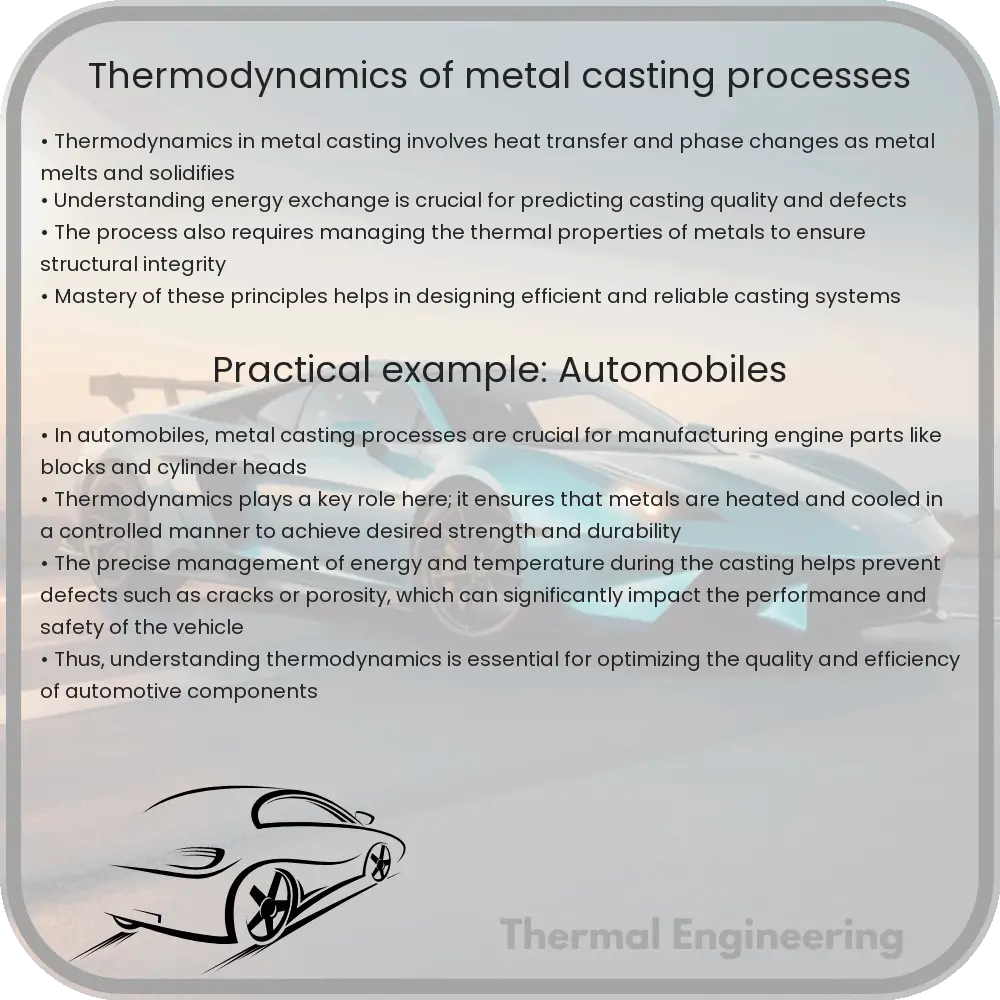Learn the role of thermodynamics in metal casting, focusing on heat transfer, phase changes, and thermal properties of metals.

Understanding the Thermodynamics of Metal Casting Processes
Metal casting is a foundational process in manufacturing and engineering, allowing the production of complex shapes from metals and metal alloys. At its core, the process involves melting a metal, pouring it into a mold where it solidifies into a desired shape, and then removing the cast part. The success and efficiency of casting largely depend on the exact management of heat or thermodynamics throughout the process. Here, we will explore the essential thermodynamic concepts that govern metal casting processes.
The Basics of Thermodynamics in Casting
Thermodynamics in metal casting primarily focuses on two main aspects: heat transfer and phase changes. The metal undergoes a transformation from solid to liquid and back to solid, which involves absorbing and releasing large amounts of heat energy. This cycle is critical to forming a quality casting without defects.
Heat Transfer in Metal Casting
Heat transfer in casting affects how the metal melts, flows, cools, and solidifies. We can break it down into three key mechanisms:
- Conduction: This is the transfer of heat through a solid material. In casting, conduction is critical as it governs how heat moves from the hotter parts of a metal to its cooler areas during solidification.
- Convection: Convection occurs in the molten metal as it is poured and as it cools in the mold. The movement of liquid metal can carry heat from one part of the mold to another, affecting the solidification rate.
- Radiation: As the molten metal and the mold are typically at high temperatures, heat is also transferred via radiation, particularly from metal surfaces exposed to the air.
Effective management of these heat transfer processes is crucial to avoiding defects such as uneven cooling, which can lead to stresses and cracks in the final product.
Phase Changes and Latent Heat
Understanding phase changes—melting and solidification—is crucial in metal casting. These changes are associated with latent heat, which is the heat required to change the state of the metal without changing its temperature. For instance:
- The latent heat of fusion is absorbed by the metal as it melts.
- The latent heat of solidification is released by the metal as it solidifies.
The amount of latent heat is significant in casting because it influences the cooling time and the overall integrity of the cast. Calculating the amount of latent heat involved allows engineers to better control the cooling rates, thus minimizing defects.
Thermal Properties of Casting Metals
The specific heat capacity, thermal conductivity, and melting point are critical properties affecting how metals respond to the thermodynamic processes in casting. Metals with high thermal conductivity, such as aluminum, disperse heat quickly, affecting how they should be handled during the casting process to ensure uniform cooling and solidification.
Practical Applications and Continuous Improvement
In industrial applications, engineers use these thermodynamic principles to design efficient casting processes. This includes choosing appropriate casting materials, designing molds that facilitate uniform heat distribution and dissipation, and controlling the environment to stabilize the temperatures involved.
Advancements in computational fluid dynamics (CFD) and thermal analysis software have further enhanced the ability to predict and control the thermodynamics of casting processes. These tools allow for precise simulations of how heat will transfer through the system, enabling better mold designs and higher quality casts with fewer defects.
By mastering the thermodynamics of metal casting, engineers can significantly affect the efficiency, cost, and quality of produced parts, demonstrating just how critical these principles are in the field of manufacturing and materials engineering.